Rustic Resin Pendants
My apologies; I have been really busy with an exciting new media; Resin! It’s so exciting to be able to show you how you can cast and form your own absolutely unique resin jewelry. Natural ‘live edge’ elements are very ‘hot’ and this has so many possibilities… but don’t blame me if you also become a ‘resin addict’! Check out my tutorial; how to make your own super-unique jewelry:
My starting point was again nature. I took some inspiration from Britta Boeckmann‘s early jewelry but wanted to be even more rustic. I am always wearing pendants, the type that make a statement. Nature supplies so many textures and designs if you open your mind to the possibilities. Go! outside! and check out what nature has to offer. There are so many amazing pieces of wood and branches and bark and leaves and… It just boggles the mind.
The Resin:
I am using a readily available resin called Alumilite Amazing Clear Cast. It is sold by many hobby and craft supplies and quite reasonably priced. It is not a polyester resin so I don’t find that it has any toxic fumes however it is still suggested to use under well ventilated conditions and avoid skin contact. (once cured, it is food safe though)
The Imbeds:
I collected a variety of wood branches. I love the great textures that bark and birch have as well as the lichen that grows on it. Anything can work within reason, that it is not too rotted or soggy. You will however need to let any wood dry thoroughly or use a very low setting to dry in an oven. Resin doesn’t like moisture!
Also, prior to embedding I like to ‘stabilize’ the wood as much as possible if it is old or soft. Stabilizing means making the wood more solid, as replacing some of the ‘air’ with a solid product. The professionals use a pressure chamber and force ‘cactus juice‘ into the wood. I use a paintable product; ‘Wood Petrifier’ that does a similar job and easier for the DIY’er. Give the pieces a good coating or 2 and let thoroughly dry. It sinks right in. The pieces can be used whole or cut as preferred, but keep the design simple. I had definite visions in my mind’s eye.
After prepping the wood I arranged how I wanted the pendants to look. I was anticipating cutting them after casting. I used a small shallow square silicone cake mold that was slightly greased with vaseline.
Mixing the resin:
The key to a good cast is having absolute exact measuring. This resin uses equal parts of A & B. I use tiny transparent cups that allow reading volume easily. Mix slowly but thoroughly until it is very clear and has no striations. Do not get over excited stirring as you don’t want to mix in any air bubbles. Scrape the sides often to make sure all is completely incorporated. This resin is quite slow to set,(30-40 minutes working time) so it lets you play with the arrangement of the items.
Here’s an important trick: WOOD FLOATS! Yes, I found that out the hard way! Pour as thin layer and set your pieces onto it. Let this cure until it is set. This will keep the wood parts from floating once they are covered with the rest of the resin. For colour I used a tiny bit of Pebeo Vitrail Ink to slightly tint the resin (turquoise). You can also have fun with leaving the swirls visible. (mix with toothpicks) I wanted the wood to be completely embedded and poured another layer to cover.
Once it is poured, a small lighter/torch or blowing with a straw will make the bubbles that are on the surface burst. Sweep quickly across the surface so as not to scorch the resin. Let it sit 24 hours or until hard. Once unmolded, I will decide the shapes I’m going to use. If your mold is the exact shape then you can skip next step.
They look wonderful and clear!
Shaping:
To cut the shapes I used my new Dremel Moto-Saw Scroll saw. It is a a great little/mighty tool or beginners who do not want to use powerful tools. To protect the resin I covered it in masking tape. Slicing them length-wise across the branches gave me the long shapes I was after.
The wood has now been sliced through as well.
Once untaped, they look wonderful already, like little blocks of frozen ice!
Finishing the Pendants:
To even out the sides I used a rough 200grit sandpaper.
Working with resin has some downfalls; sanding! My intention was NOT to make any dust by dry sanding, as it is a nasty health hazard! Once the surfaces were pretty even, I mixed up a bit of resin and spread it carefully over the rough ends, and let it dome. Do not over-pour or it will drip down the sides. Just drip a bit and spread it out, it will self-level.
I wanted all the wood to be encapsulated in resin to allow wet sanding without the wood pieces absorbing water.
You will see the great shine it also makes.
Coming along nicely…
Wet Sanding:
Once they are coated on all sides, the wet sanding can start. Once Alumilite is cured it is food safe, and the water keeps any dust from forming. I use a large cafeteria tray to catch any stray water and work through the grits of wet/dry sandpaper.
The sequence: (wet/dry sandpapers may be found in the automotive area of the hardware stores)
- 200/220 grit – rough shaping
- 400 grit – medium smoothing
- 600 grit – medium-fine shaping
- 1000 grit – fine for removing scratches from shaping
- 2000 grit – super fine sanding
- Novus #2 Scratch remover (liquid polish)
- Carnauba Wax for shine
Shaped with 220 grit
Edges softened with 400 and 600 grit.
Further smoothing with 1000 and 2000 grit.
Polished with Novus #2
There may be other polishes that also work, but these are great. (and who knows if the car headlights will need some someday). Inspect your piece and backtrack if you find scratches. Use some muscle to be thorough with wet-sanding. Rinse in between grits (keep a bowl of slightly soapy water handy) When it looks good, use a car wax or the Novus #1 to shine the piece.
Finishing Touches
To be able to hang your pendant you will need some sort of way to hold the chain or cord. Bails are available that can be glued or attached with a small hole. I decided that a drilled hole would be simple and strong.
My Dremel is mounted in a Workstation to allow drill press type work. It is a super handy addition to the already great tool.
It is so satisfying to see such a transparent shiny artifact that is hand created and can also be worn. See more here
Closeup inspection and you see the lichen frozen in time.
Be creative! And proudly wear your piece of unique jewelry! High five! Alright, alright, if you’d rather just buy one; check out my new Etsy store. It’s what happens when you just love ‘making’ and make too much…
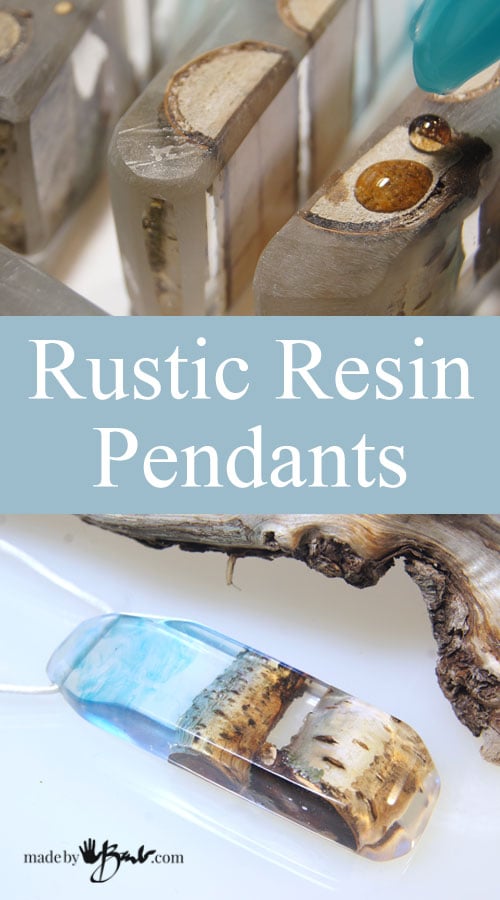
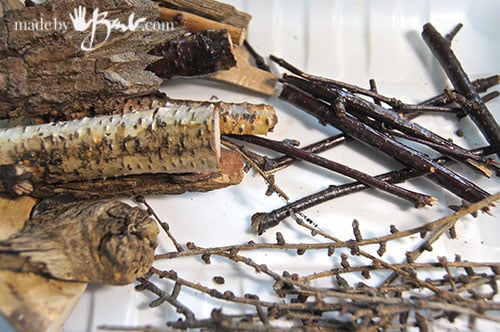


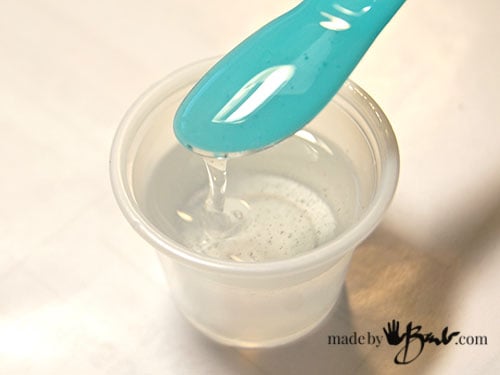
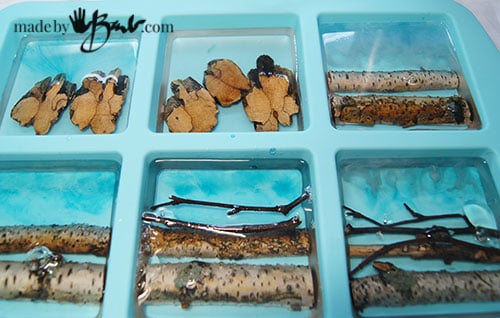




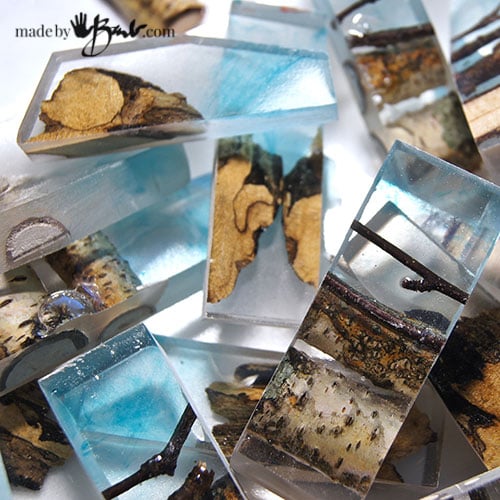
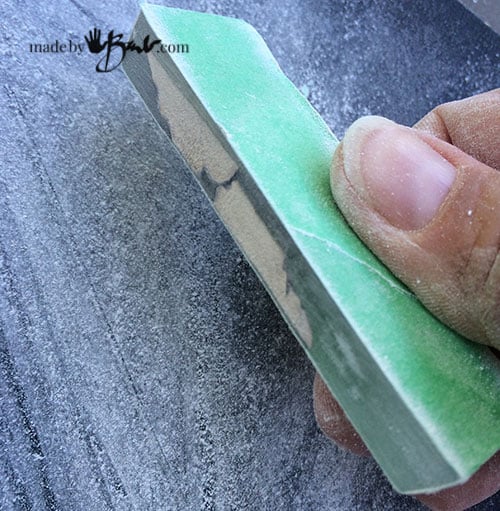

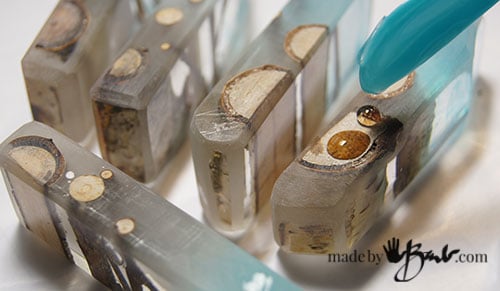

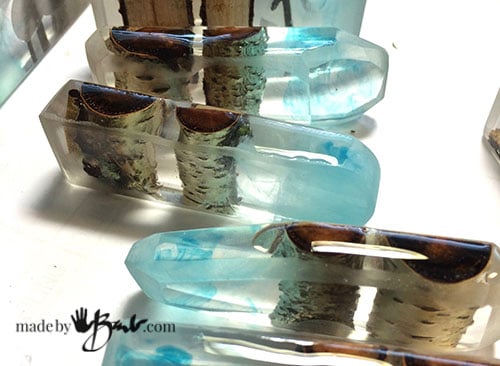

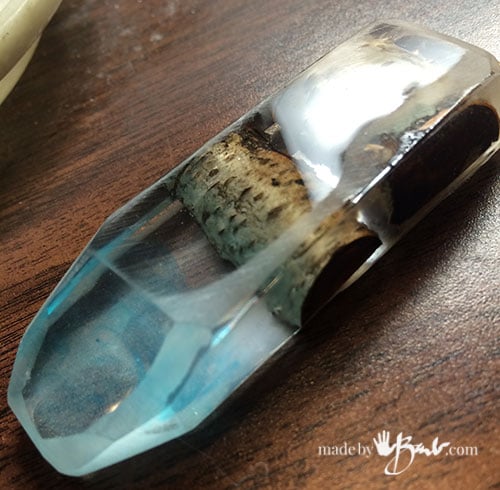

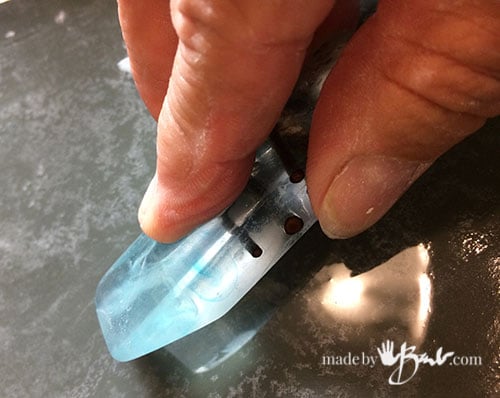
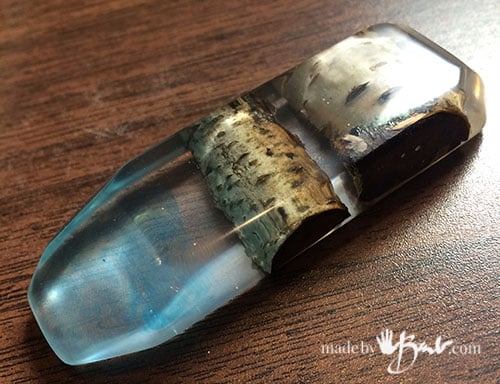


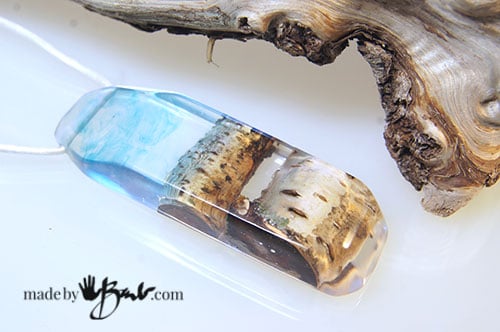
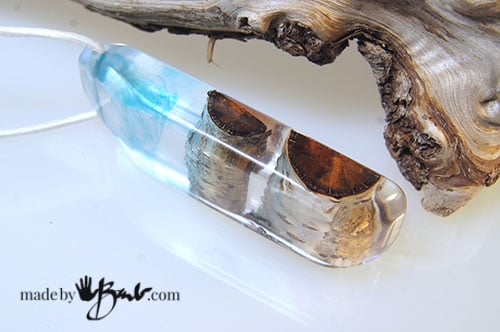
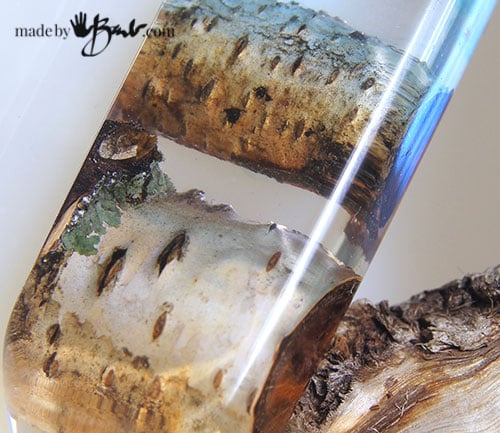

Hi Barb, was wondering if you would provide information on how use the oven to dry your wood? Temperature and time? Also, how do you perfect the final shapes of these? To make them symmetric? Thanks so much!
I’ll try to help: I’d say it is just to provide a bit of warmth so the lowest setting, 150ºF. I am not sure how much time as your wood could be very wet or just a bit damp. You can probably tell a bit by feel or get one of those fancy moisture meters that you prong into the wood.
As for the perfecting of shapes, I would just use my eye and keep turning and looking. I am not always after perfect symmetry since I find that a bit dull. There is really no rules as to what would look great. Go with your ‘gut’ as to whether you like the shape or get inspiration from the internet. I like them to have personality…
Good luck
Thanks so much Barb! I am so excited you gave me direction with this! I’ve been wanting help for so long! You are a gem…
Barb thank you so much for the clear, concise, beautifully photographed tutorial. I had stared at the pictures on Pinterest, completely flummoxed trying to imagine how it was done. You not only gave instruction, you informed me on products I didn’t even know were available–I’m getting a Dremel Workstation thanks to you! Sanding is difficult for me due to Arthritis, but I’m determined to start designing and then job that sanding task out. Again, thank you. I’m so excited!
I am glad to help. I think some people like to keep it a secret so that others can’t do it… I was experiencing the same mystery when I started. If could I would have every tool AND a huge workshop with dust vacuums! However that won’t happen so I try to improvise! Using electric sanding tools is great but I caution you about the dust; it is very bad/unhealthy to inhale hence I liked the wet sanding. When I used the electric tools I did so outdoors to minimize the dust.
It’s great to be creative but health comes first. Share how they turn out!
Your ideas are out of the box, your artistic soul show it in everyone of your pieces ❤️
Awe, that’s a nice compliment. Thanks. When I started this site my intentions were NOT to just rehash others’ DIY, but to have unique projects.
I have no shortage of ideas, however the time to make, photograph, write etc is sometimes a challenge!
Oh Barb – these are GORGEOUS – I have been collecting branches with lichen and have been so ready to try this – thanks for sharing your info and product choices – cannot wait to do this!
Thanks! As with anything new I try, I always do small tests first. Happy making and learning!
Hi Barb!
I was wondering if you could help me with what types of wood to use to get the effect that you do. I recently just discovered working with resin and wood and I’m super excited to do It! Some of the works I have seen and just amazing! Also, how do you get the effect of waves, or what looks like smoke I guess.
Thanks for any input!
Ah, there is just so much that is possible with resin! I think there is not any kind of wood that you can’t use. If you use pieces that have a lot of holes in them it is more likely that they will trap some bubbles, and if the are too ‘punky’ then the finished piece may fall apart. If you check out the ‘pen-turners’ you will see that they use vacuum/pressure to make the resin penetrate and also use cactus juice to stabilize wood.
Yes, I bet you are now confused, but start with easier projects. I like the simplicity of a nice branch with a bit of lichen on it. or a slice of burly wood. BTW, Wood floats so pour 2x or weigh it down.
The smoky waves are made with pigments that are swirled once the resin is getting thicker. Titanium Dioxide makes the whitish swirls. I have it for soap making, super white powder.
Hope that helps.
Oh my goodness; these pendants are wonderful! I have the resin supplies but am hesitant as my first try was full of bubbles and looked terrible. I am doing postage stamps and hopefully flower petals….. Thanks for the inspiration!
Thanks! Yes, bubbles can be a problem. The ones that form on the surface can be bursted with a quick pass of a mini torch over the surface. Some have suggested just blowing with a straw as well. Mix carefully not to add more bubbles. If the wood has a lot of small voids there is more chance of bubbles getting stuck as well. Sometimes it takes a bit of playing with a toothpick to get rid of the bubbles, as my resin had a fair amount of work time. The pros invest in pressure and vacuum chambers. Good luck!
Hello Barb!
I wanted to congratulate you on your creations. Everything is stunning. In particulare I fell in love on your wood and resin Creations. I would like to try to do them!
Regards from Lucca, Italy
Lara
Grazie! ‘Amazing how far and wide I can inspire some ‘making’. Good luck! And you have access to the lovely olive wood…
I have been working with resin for several years and like so many have wanted to make these pendants with the wood and the color. I tried all kinds of things and finally got frustrated. So thank you for posting the instructions. Art should speak to you and these do for me. My problem was how to keep the color off the wood. I also was told to use the glow in the dark powder. It didn’t work for me. Also thank you for listing the products and why you do certain things. I found out the hard way resin warps when it gets hot. Did tables with a thin coat of resin and on a enclosed porch that reach 95 degrees they warped. Again thank you so much for sharing your adventures with us.
I am happy that you enjoy working with resin! I am not sure why you were having problems with the colour on the wood. I use a tiny bit of colour in the resin and it just gives a slight colour. It does not actually effect the wood. As with so many art forms and crafts, it is always a learning experience. I tend to get obsessed and fixated until I get it to work! Darn determination…
Hi Barb,
Can’t tell you how much I appreciate your VERY detailed instructions for this beautiful resin pendant. Your photos are amazing, too. Thank you so much for posting this and I look so forward to looking at your other DIY tutorials!!!
Thank you! That is kind but appreciated. Since I’ve taught for many years I tend to be pretty thorough. Yes, do spread the word…
I’m going to try my hand at making a resing ring with flowers. Should I dry the flowers first or can I add them straight to the resin?
I have not used flowers as I had read they can be troublesome due o drying or reacting to the resin and turning brown. I like to make my verso of unique projects and flowers seemed somewhat typical. Resin obsession site does have a lot of info as do facebook groups… Good Luck